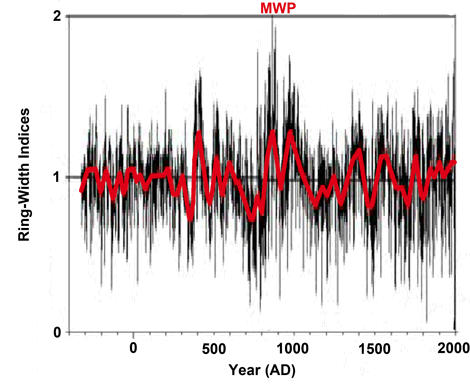Reference
Zhang, Q.-B., Cheng, G., Yao, T., Kang, X. and Huang, J. 2003. A 2,326-year tree-ring record of climate variability on the northeastern Qinghai-Tibetan Plateau. Geophysical Research Letters 30: 10.1029/2003GL017425.
Description
Zhang et al. collected tree-ring samples from (1) well-preserved Sabina przewalskii tree trunks that had been used as building blocks in ancient tombs in the Dulan area (35°50' ~ 36°30'N, 97°40' ~ 98°20'E) of the Qinghai-Tibetan Plateau, (2) tree trunks employed in building local cabins, and (3) living sabina trees in the same area, in order to crossdate annual growth rings of the ancient tree trunks and establish a climate-growth relationship for the trees, which they accomplished using regional means of climatic data measured at three nearby meteorological stations over the period 1953-2000. This work allowed them to reconstruct an annually-resolved 2,326-year tree-ring chronology (stretching from 326 BC to AD 2000) that was "most strongly correlated with the spring precipitation (May-June, r = 0.58, p < 0.001)," which indicates, in their words, that "moisture stress in [the] growing season is a major limiting factor to tree-ring growth." In addition, they state that "this result is in general agreement with that observed in dendro-climatological studies of the same species in other areas of the Qinghai-Tibetan Plateau, suggesting that the annual growth rings mainly reflect variations in regional spring precipitation." As shown by the graphical representation of their data in the figure below, therefore, we conclude that the MWP in the Dulan area (as defined by spring precipitation) held sway from about AD 820 to AD 1100.

Sabina przewalskii ring-width indices vs. year, derived from trees of the Dulan area of the Qinghai-Tibetan Plateau. Adapted from Zhang et al. (2003).
With respect to the data depicted above, Zhang et al. additionally say that "corresponding to the North Atlantic MWP, the ring widths were increased ... during AD 929-1031, with the peak occurring around AD 974," and they go on to state that these observations mesh well with what Esper et al. (Science 295: 2250-2253) had earlier found, i.e., that "long tree-ring chronologies in the Northern Hemisphere extra-tropics ... indicated that the warmest period covers the interval AD 950-1045, with the peak occurring around AD 990." This observation further suggests that the peak warmth of the Dulan area likely also occurred at this time, implying that the peak warmth of the MWP in that part of the world was greater than the peak warmth experienced there during the late 20th century.




